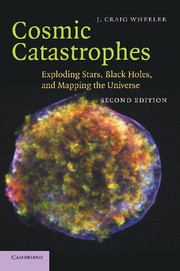Book contents
- Frontmatter
- Contents
- Preface
- 1 Setting the stage: star formation and hydrogen burning in single stars
- 2 Stellar death: the inexorable grip of gravity
- 3 Dancing with stars: binary stellar evolution
- 4 Accretion disks: flat stars
- 5 White dwarfs: quantum dots
- 6 Supernovae: stellar catastrophes
- 7 Supernova 1987A: lessons and enigmas
- 8 Neutron stars: atoms with attitude
- 9 Black holes in theory: into the abyss
- 10 Black holes in fact: exploring the reality
- 11 Gamma-ray bursts, black holes and the Universe: long, long ago and far, far away
- 12 Supernovae and the Universe
- 13 Wormholes and time machines: tunnels in space and time
- 14 Beyond: the frontiers
- Index
3 - Dancing with stars: binary stellar evolution
Published online by Cambridge University Press: 14 September 2009
- Frontmatter
- Contents
- Preface
- 1 Setting the stage: star formation and hydrogen burning in single stars
- 2 Stellar death: the inexorable grip of gravity
- 3 Dancing with stars: binary stellar evolution
- 4 Accretion disks: flat stars
- 5 White dwarfs: quantum dots
- 6 Supernovae: stellar catastrophes
- 7 Supernova 1987A: lessons and enigmas
- 8 Neutron stars: atoms with attitude
- 9 Black holes in theory: into the abyss
- 10 Black holes in fact: exploring the reality
- 11 Gamma-ray bursts, black holes and the Universe: long, long ago and far, far away
- 12 Supernovae and the Universe
- 13 Wormholes and time machines: tunnels in space and time
- 14 Beyond: the frontiers
- Index
Summary
MULTIPLE STARS
Cecelia Payne-Gaposhkin was a pioneer of modern astronomy. She devoted much of her research to the study of multiple star systems and coined a comic adage to describe one of the basic tenets of that work: “Three out of every two stars are in a binary system.” By this she meant to illustrate that roughly half the stars in the sky have companion stars in orbit. If you were to look closely at half the stars you would find that there are two stars, where a more casual examination would have revealed only one point of light. Many people know that the nearest star to the Sun is Alpha Centauri. Less well known is that Alpha Centauri has a companion in wide orbit, known as Proxima Centauri. A closer examination shows that Alpha Centauri itself is not a single star but has a closely orbiting companion as well. Of the “two” stars closest to the Sun, three are in the same mutually orbiting stellar system.
Stars occur in many combinations. Single stars and pairs are most common, but some systems contain four or five stars in mutual orbit. In this chapter, we will concentrate on the systems with a pair of stars, double stars, or, somewhat more technically, binary stars (but we try to refer to the phenomenon of duplicity, not the word “binarity” born of mangled jargon that has crept into the literature). Binary stars come in two basic classes: wide and close.
- Type
- Chapter
- Information
- Cosmic CatastrophesExploding Stars, Black Holes, and Mapping the Universe, pp. 42 - 54Publisher: Cambridge University PressPrint publication year: 2007



